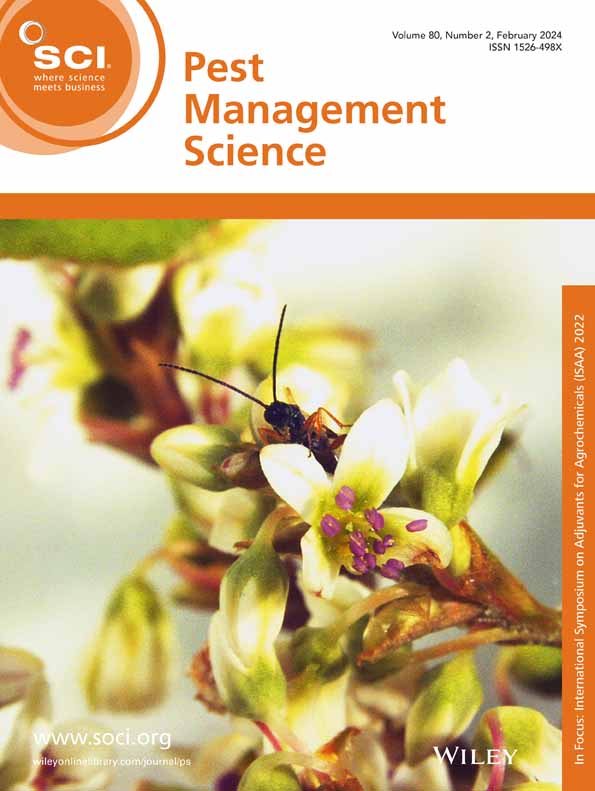基于RPA-CRISPR-LbaCas12a-LFD系统的木质素水蛭高特异性和超灵敏度检测方法
IF 3.8
1区 农林科学
Q1 AGRONOMY
引用次数: 0
摘要
背景木质素水陆甲虫(hylurgus ligniperda)是一种入侵性树皮甲虫,对全球针叶林和木材贸易构成严重威胁。寄主范围广、繁殖潜力大、环境适应性强,使其能在新入侵地区迅速建立和传播。2020年10月,H. ligniperda在中国山东省首次被报道。开发一种快速、灵敏、准确的现场检测方法对于早期拦截和有效管理至关重要。结果建立了一种基于重组酶聚合酶扩增(RPA)和CRISPR/Cas12a结合的木质素木质素木质素木质素木质素木质素木质素木质素木质素木质素木质素木质素木质素木质素木质素木质素木质素木质素木质素木质素木质素木质素木质素木质素木质素木质素木质素木质素木质素木质素木质素木质素木质素木质素木质素木质素木质素木质素木质素选择线粒体COI基因作为靶序列,对孵育时间、温度、Cas12a蛋白和CRISPR RNA (crRNA)浓度等关键参数进行优化。RPA-CRISPR-LbaCas12a-LFD试验表现出较高的特异性和敏感性,成功区分h . ligniperda从五个密切相关的物种,并检测目标DNA浓度低至1份/μL。最后,利用全球地理种群样本验证了该检测系统的现场适用性。结论本研究建立了一套基于RPA-CRISPR-LbaCas12a-LFD的便携式、快速、灵敏的木质素木门菌视觉检测系统,适用于实验室和现场应用。该方法无需专门设备即可进行现场检测,为入侵性有害生物监测、港口检疫和早期预警提供了强有力的工具。©2025化学工业协会。本文章由计算机程序翻译,如有差异,请以英文原文为准。
A highly specific and ultrasensitive approach to detect Hylurgus ligniperda based on RPA-CRISPR-LbaCas12a-LFD system.
BACKGROUND
Hylurgus ligniperda is an invasive bark beetle that poses a serious threat to global coniferous forests and the timber trade. Its broad host range, high reproductive potential, and strong environmental adaptability enable it to establish and spread rapidly in newly invaded regions. In October 2020, H. ligniperda was first reported in Shandong Province, China. Developing a rapid, sensitive, and accurate field detection method is critical for early interception and effective management.
RESULTS
We developed a detection method for H. ligniperda based on recombinase polymerase amplification (RPA) coupled with CRISPR/Cas12a, with results monitored via fluorescence signals and lateral flow dipstick (LFD). The mitochondrial COI gene was selected as the target sequence, and key parameters-including incubation time, temperature, and concentrations of Cas12a protein and CRISPR RNA (crRNA)-were optimized. The RPA-CRISPR-LbaCas12a-LFD assay exhibited high specificity and sensitivity, successfully distinguishing H. ligniperda from five closely related species, and detecting target DNA at concentrations as low as 1 copy per μL. Finally, The field applicability of the detection system was validated using samples from global geographic populations.
CONCLUSION
This study establishes a portable, rapid, and sensitive visual detection system for H. ligniperda based on RPA-CRISPR-LbaCas12a-LFD, suitable for both laboratory and field applications. The method enables field detection without the need for specialized equipment, offering a robust tool for invasive pest surveillance, port quarantine, and early warning. © 2025 Society of Chemical Industry.
求助全文
通过发布文献求助,成功后即可免费获取论文全文。
去求助
来源期刊

Pest Management Science
农林科学-昆虫学
CiteScore
7.90
自引率
9.80%
发文量
553
审稿时长
4.8 months
期刊介绍:
Pest Management Science is the international journal of research and development in crop protection and pest control. Since its launch in 1970, the journal has become the premier forum for papers on the discovery, application, and impact on the environment of products and strategies designed for pest management.
Published for SCI by John Wiley & Sons Ltd.
 求助内容:
求助内容: 应助结果提醒方式:
应助结果提醒方式:


